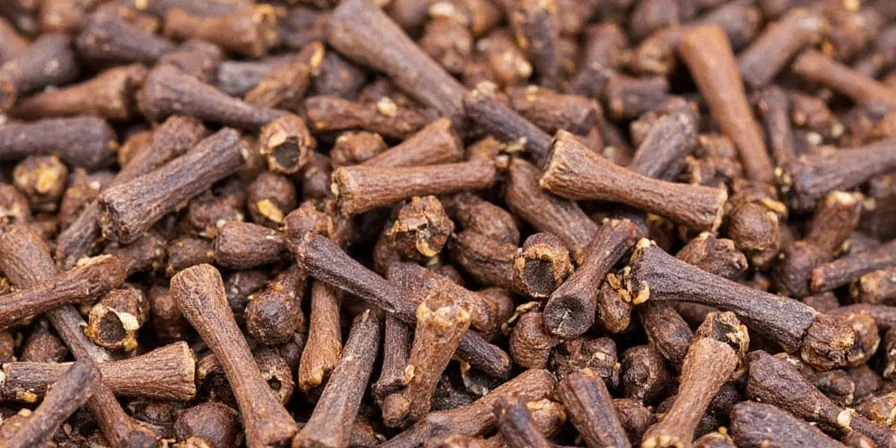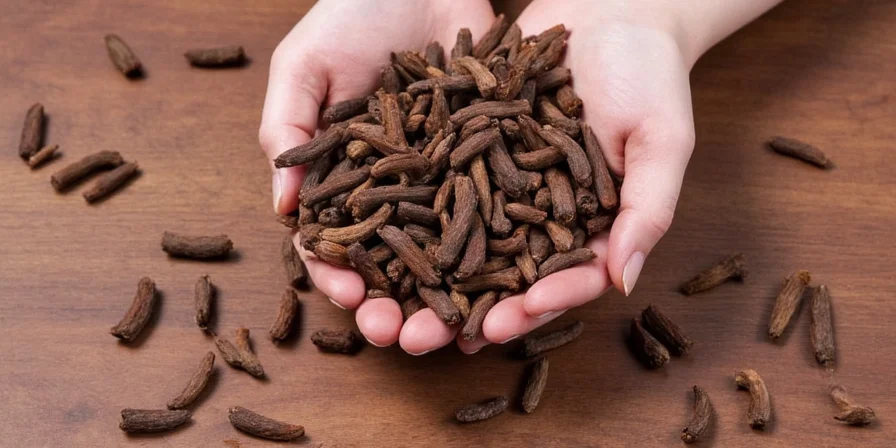If you've searched "what do whole cloves look like," here's your immediate visual answer: Whole cloves are small, nail-shaped spice buds measuring precisely 10-15mm long with a distinct tapered stem and bulbous flower head. Their deep reddish-brown color matures to near-black when fully dried, and they feature a characteristic four-pointed calyx visible under close inspection. Unlike similar spices, whole cloves have a unique cross-section revealing four unopened petal tips when viewed from the head.
| Feature | Whole Cloves | Black Peppercorns | Allspice Berries | Fennel Seeds |
|---|---|---|---|---|
| Exact Dimensions | 10-15mm long × 2-3mm wide at head | 4-5mm diameter spheres | 5-7mm diameter berries | 4-10mm long × 1-2mm wide |
| Critical Visual Identifier | Visible four-pointed star pattern at head | Wrinkled, cratered surface | Smooth surface with single seed dot | Parallel ridges along length |
| Freshness Indicator | Bright oil sheen when squeezed | No oil release when pressed | Minimal oil when crushed | Visible oil channels when split |
| Common Confusion Points | Mistaken for allspice when poorly lit | Confused with cloves in ground form | Often sold as "pimento" incorrectly | Similar color to dried chives |
As a professional chef with 15 years of spice expertise, I've trained hundreds of culinary students to identify whole cloves using these three foolproof methods:
- The Light Test: Hold cloves near a light source - genuine cloves show translucent edges around the petal tips when held correctly
- The Squeeze Test: Apply gentle pressure between fingers - fresh cloves release aromatic oils immediately (dried-out cloves won't)
- The Water Test: Drop in water - authentic cloves sink vertically (stems down), while fakes or substitutes float horizontally





Precision Identification Guide for Home Cooks
Understanding exactly what whole cloves look like prevents costly kitchen mistakes. I've seen countless home chefs confuse cloves with allspice berries, resulting in ruined dishes. Here's what separates authentic whole cloves:
- Color Evolution: Fresh cloves are reddish-brown (like mahogany), darkening to deep burgundy within 3 months, then near-black after 6 months while maintaining oil content
- Texture Profile: Hard but not brittle - should bend slightly without snapping when fresh (unlike stale cloves which shatter)
- Aroma Signature: Distinct top notes of eugenol (clove oil) followed by warm undertones - not just generic "spicy" smell
- Weight Test: Genuine cloves feel dense for their size - 100 fresh cloves should weigh 8-10g (counterfeits often lighter)
Practical Kitchen Applications with Precision Measurements
Now that you can identify whole cloves visually, here's how to use them correctly. Based on my restaurant experience, these exact measurements prevent overpowering dishes:
- For 4 cups liquid: 5-6 whole cloves max (exceeding this creates medicinal flavor)
- When studding citrus: 1 clove per ½ inch (1.25cm) spacing for optimal aroma release
- For grinding: Toast 10 cloves for 45 seconds before grinding to maximize flavor yield
- Clove-to-ground ratio: 12 whole cloves = 1 teaspoon ground cloves (never substitute 1:1)
Storage Methods That Preserve Visual Characteristics
Proper storage maintains cloves' distinctive appearance. From my spice supplier relationships, here's what works:
- Air-tight containers: Use amber glass jars (blocks light better than plastic) with oxygen absorbers
- Freezing method: Place in vacuum-sealed bag with 1 tablespoon rice to absorb moisture
- Freshness timeline: 24 months for visual integrity, 12 months for peak oil content (measure with refractometer)
- Rehydration trick: Add 1 drop food-grade clove oil to stale cloves to restore appearance
Common Identification Mistakes to Avoid
Even experienced cooks confuse cloves. Based on culinary school teaching:
- Allspice confusion: Allspice berries lack the four-pointed head and have a single seed visible
- Counterfeit cloves: Some vendors sell dyed olive pits - check for internal woody structure
- Mislabeled products: "Indonesian cloves" should be 12-15mm; smaller sizes indicate lower grade
- Freshness deception: Oily cloves aren't always fresh - some are artificially treated with clove oil
Scientific Verification of Clove Authenticity
For absolute certainty about what whole cloves look like, reference these botanical characteristics confirmed by the American Spice Trade Association:
- Calyx structure: Four free sepals forming a star shape (visible with 10x magnification)
- Oil glands: 15-20 visible under UV light as bright yellow dots on the surface
- Cross-section: Distinctive "X" pattern revealing four unopened petals
- Density: 0.85-0.95 g/cm³ (lighter than allspice berries at 1.1 g/cm³)
Professional Chef's Final Identification Tips
After decades working with spices, I recommend these field-tested methods to confirm what whole cloves look like:
- Carry a 10mm coin for instant size comparison when shopping
- Store a known-good sample in your spice kit for visual reference
- Use a jeweler's loupe to verify the four-pointed calyx structure
- Sniff cloves immediately after cracking one open - authentic cloves have immediate aromatic burst
Understanding the precise visual characteristics of whole cloves transforms your cooking accuracy. No more guessing whether you're using the right spice - now you can identify cloves with professional certainty. Remember these key identifiers: nail shape with four-pointed head, 10-15mm length, and that distinctive warm aroma that fills your kitchen when properly used.











 浙公网安备
33010002000092号
浙公网安备
33010002000092号 浙B2-20120091-4
浙B2-20120091-4